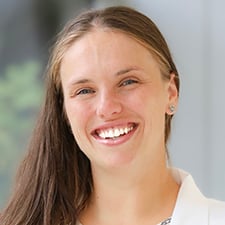With one child already and another on the way, there was a lot on the line for Paulina E. McCabe, DO, as she was wrapping up her family medicine residency in 2024.
She and her husband Jared knew they wanted to remain in Delaware, where he had grown up, but they also knew they needed her job to provide flexibility for them to share parenting duties. Besides her dream of becoming a physician, they aspired to leverage Jared’s fitness training to open a CrossFit gym.
One of the keys to making everything work at the same time, though, was finding an employer that would allow Dr. McCabe to work slightly less than full time. They were comfortable sending their kids to daycare three days per week but no more than that.
“I'm actually a 0.9 employee versus a 1.0 employee, so I work one less half day per week, and my admin day is remote—so I can stay home on Tuesdays,” she said in an interview with the AMA—on a Tuesday. Jared “stays home on Wednesdays.”
Dr. McCabe had no trouble finding such an employer, because it was the same nonprofit Delaware health system, Bayhealth, where she had completed her residency training. In fact, she had first encountered Bayhealth during medical school at Philadelphia College of Osteopathic Medicine, when it was one of her clinical rotations.
Bayhealth has more than 5,000 employees and 400 physicians in Central and Southern Delaware, and is a member of the AMA Health System Program that provides enterprise solutions to equip leadership, physicians and care teams with resources to help drive the future of medicine.
"I really fell in love with the Bayhealth system and the people who worked at the hospital,” Dr. McCabe said. “They seemed to have a genuine interest in medical students and trying to help us out. It was a newer program, and I think that helped because they were super passionate about it.”
So when she made her Match rank-order list, she put Bayhealth at the top of it.
“They really wanted to have us as residents be a part of building that program, which I thought was very interesting,” she said. “I realized I could be a part of something new and they would listen to my input.”
The AMA Transitioning to Practice series has guidance and resources on deciding where to practice, negotiating an employment contract, managing work-life balance, and other essential tips about starting in practice.
Having a plan helps everyone
Dr. McCabe’s son, Henry, is 2 1/2, and her daughter, Gabi, was born in December. With just a couple of months on the job, her parenting schedule already has gone off as planned, owing largely to her not having to relearn her work environment.
“I wanted to stay within Bayhealth so it wouldn't be a complete 180. For example, I’m used to the EMR—I have all my dot phrases,” said Dr. McCabe, who took a position at Bayhealth Primary Care in Milford, Delaware. “Getting to know a health care system takes time, so it was nice that I had a little bit of background in my transition. And I think that made family life easier.”
She had started her job-search process the summer before her final year of residency. One thing on her wish list was avoiding a gap in health insurance coverage. Another priority: maintaining eligibility for the Family and Medical Leave Act. The federal labor law entitles employees of covered employers to take unpaid, job-protected leave for qualified medical and family reasons, but the mandate only applies after one year of employment. Remaining employed at Bayhealth could preserve her eligibility.
“I said: ‘I don't want to start the process over. Is there any way I can roll over my benefits because I've worked in this health system for three years?’” Dr. McCabe recalled. Officials at Bayhealth “were really good at working with me to accomplish that. I didn't have to discontinue my contract and start a new one.”
If you’re seeking your first physician job post-residency, get your cheat sheet now.
Dive deeper:
- What to look for when onboarding at your first physician job
- In transition to practice, know these 8 steps for evaluating jobs
- When seeking new physician job opportunities, follow this advice
- What I wish I knew in residency about being an employed physician
Big questions to ask yourself
Looking back on her transition to practice, Dr. McCabe identified several key questions that resident physicians should ask themselves when evaluating job opportunities.
“The most important question that you have to ask yourself is: What kind of lifestyle do I want for myself? That goes for any specialty,” she said. “I wanted to spend as much time with my family as I could, so going the 0.9 route instead of being full time was a big deal and one of the reasons why I really wanted to stick with Bayhealth—because they were willing to work with me on that.”
Another big question: Where do you see yourself living down the line?
“For example, if you want to move back home to be with your family, then location might be the most important thing to you,” she said.
In addition: How do you envision your practice?
“If you’re in family medicine, for example, do you want to still see kids? I wanted to see kids, so I looked for a health system that said, ‘Yes, this is how we make it work,’” she said.
Lastly, it’s important to know whether the employer’s onboarding allows for adequate ramp up. In Dr. McCabe’s case, she also needed protected time and space for pumping breast milk.
“Will you be seeing five to 10 patients per day? Or will they ask you to see 20 patients per day immediately? You want your first few weeks to be very light so you can get used to the EHR and all the processes,” Dr. McCabe said, adding that it’s important to know the employer’s policies around matters such as the patient portal. “If you’re getting swamped with patient messages, do you have to answer them within a certain time frame? Will you get help from, say, the nursing staff?”
In the end, medicine is much like other lines of work: It’s about building and maintaining good relationships.
“Find a place where you feel like you fit in,” she said. “Teamwork and atmosphere are very important things that we often don't think about when we're looking for a job.”
For residents transitioning to practice or those already in practice who are considering a midcareer switch, an AMA STEPS Forward® toolkit, “What to Look for in Your First or Next Practice: Evaluate the Practice Environment to Match Your Priorities,” will help you identify available practice settings and understand how they may impact your experience, clarify your priorities, and tailor your search for a fulfilling career in a positive and supportive environment.
Learn about the AMA Young Physicians Section, which gives voice to and advocates on issues that affect physicians under 40 or within the first eight years of professional practice after their training as residents and fellows.




